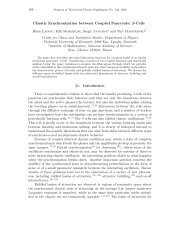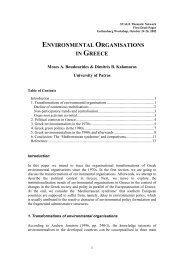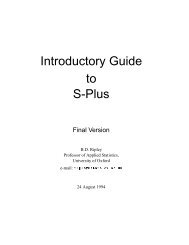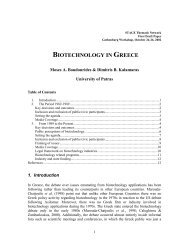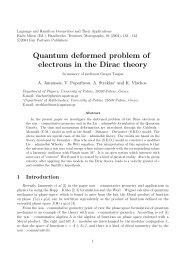mathematical models for biomagnetic fluid flow and applications
mathematical models for biomagnetic fluid flow and applications
mathematical models for biomagnetic fluid flow and applications
Create successful ePaper yourself
Turn your PDF publications into a flip-book with our unique Google optimized e-Paper software.
<strong>for</strong> medium shear rates, like blood <strong>flow</strong> in artery, the diffusion of the spin term is much<br />
smaller than that of the magnetic torque or the exchange between internal <strong>and</strong> external<br />
momentum.<br />
The major simplification however, can take place if we consider that the magnetic <strong>fluid</strong> has<br />
either achieved instantaneous magnetization or time has elapsed beyond the relaxation time,<br />
after the <strong>flow</strong> has exposed to the magnetic field. In this situation the <strong>flow</strong> can be considered<br />
as equilibrium <strong>flow</strong> <strong>and</strong> once the particle reaches saturation magnetization it will not have<br />
addition magnetization even if the magnetic field is further increased. Under the equilibrium<br />
assumption the <strong>fluid</strong> magnetization vector, M , at any given instant is parallel to the vector of<br />
the magnetic field intensity, H , <strong>and</strong> the property of magnetization is determined by the <strong>fluid</strong><br />
temperature, density <strong>and</strong> magnetic field intensity M=M(T,ρ,H). Although the equilibrium<br />
<strong>flow</strong> is an idealization <strong>for</strong> the physical behavior of the <strong>biomagnetic</strong> <strong>fluid</strong>, it provides a good<br />
insight to the <strong>biomagnetic</strong> <strong>fluid</strong> <strong>flow</strong> since the governing equations are much more simpler<br />
than the complete set of equations derived in the previous sections <strong>for</strong> non equilibrium case.<br />
The equations of motion <strong>for</strong> the equilibrium <strong>flow</strong> can be written now as:<br />
Continuity Equation<br />
<br />
∇⋅ V=<br />
0, (6)<br />
Linear Momentum<br />
<br />
DV <br />
2<br />
ρ =−∇ p+ρ F+η∇ V+µ oMo∇H, (7)<br />
Dt<br />
1/2<br />
2 2<br />
where H= ⎡<br />
⎣Hx<br />
+ H ⎤<br />
y⎦<br />
.<br />
3.2 Saturation Magnetization Equations<br />
In equilibrium situation the magnetization property is generally determined by the <strong>fluid</strong><br />
temperature, density <strong>and</strong> magnetic field intensity <strong>and</strong> various equations, describing the<br />
dependence of M o on these quantities, are given in bibliography [6], [7]. The simplest relation<br />
is the linear equation of state, given in [8]:<br />
M = K( T −T), (8)<br />
o<br />
c<br />
where K is a constant called pyromagnetic coefficient <strong>and</strong> T<br />
c<br />
is the Curie temperature.<br />
Above the Curie temperature the bio<strong>fluid</strong> does not subjected to magnetization.<br />
Another equation <strong>for</strong> magnetization, below the Curie temperature is given in [9]<br />
M<br />
c<br />
o<br />
=<br />
1⎜ ⎟<br />
⎝ T1<br />
⎠<br />
)<br />
β<br />
⎛T<br />
− T⎞<br />
M , (9)<br />
where β is the critical exponent <strong>for</strong> the spontaneous or saturation magnetization. For iron<br />
β=0.368, M 1 =54 Oe <strong>and</strong> T 1 =1.45 K.<br />
A linear equation involving the magnetic intensity H <strong>and</strong> temperature T is given in [10]<br />
M = KH T −T<br />
. (10)<br />
o<br />
(<br />
c<br />
Finally, Higashi et. all [4], found that the magnetization process of red blood cells behaves<br />
like the following function, known as Langevin function,<br />
⎡ ⎛µ omH<br />
⎞ κT<br />
⎤<br />
Mo<br />
= mN⎢coth⎜ ⎟− ⎥<br />
⎣ ⎝ κ T ⎠ µ<br />
omH<br />
, (11)<br />
⎦<br />
where m is the particle magnetization, N is the number of particles per unit volume <strong>and</strong> κ the<br />
Boltzman’s constant.<br />
T c



